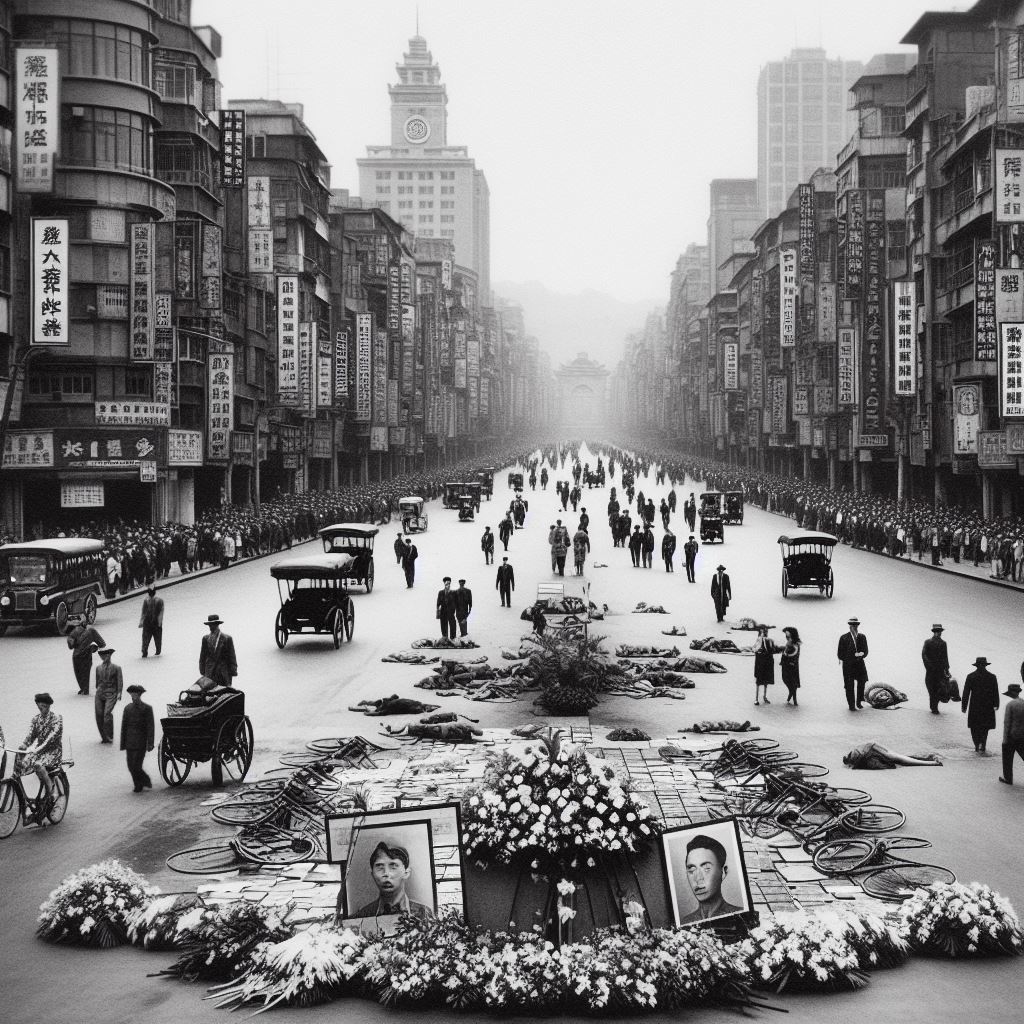台灣228事件。
台灣的228是一個悲劇的歷史事件,發生於1947年2月28日。這場事件的起因是一起警察濫權濫捕事件,導致台北市一名婦女被警察毆打,憤怒的民眾開始對當局表達不滿。然而,政府當局的鎮壓行動卻引發更廣泛的抗議浪潮,民眾要求政治改革和司法公正。
在接下來的幾天裡,抗議活動蔓延到全台各地,成千上萬的人走上街頭示威,要求政府改革。然而,政府當局以極端的手段回應,宣布戒嚴,派遣軍隊鎮壓抗議活動,逮捕大量抗議者。據估計,事件導致上千人死亡,成千上萬人被捕,更有大量人口失蹤,許多家庭破碎。
導致228事件爆發及後期白色恐怖的原因複雜多樣,主要是由政治、經濟和社會因素相互交織而成的。以下是導致228事件爆發和後來白色恐怖的一些主要因素:
軍政府鎮壓政策:台灣當時處於蔣介石國民政府的管轄之下,當時在國共內戰中落敗,於是開始在島上實行嚴格的軍事管制。政府官員和警察對民眾採取嚴厲的鎮壓措施,許多疑似與共產黨有關或是反政府人士都紛紛入獄或是處決,最終導致事件的爆發。
經濟不穩定:二戰結束後,台灣經濟面臨巨大挑戰,通貨膨脹、物價上漲、失業率上升等問題嚴重影響人民生活。民眾對政府的經濟管理不滿,加劇社會緊張局勢。主要是國民黨透過新台幣的發行來兌換舊鈔,將許多台灣人的財富大幅縮水,眾多企業紛紛破產。
政治壓迫和民主訴求:在國民黨政權下,政治壓迫和腐敗現象嚴重,人民對民主和政治自由的訴求日益增加。事件爆發前,政府對反對黨和異議人士進行鎮壓,加劇社會不滿情緒。當時部分士兵沒有紀律,吃霸王餐事件屢見不顯或是屢次發生坦克在路上壓死的人事件,都沒有任何的處理。
歧視與不平等:事件爆發時,台灣社會存在著地方人士與外省人士之間的歧視和不公平現象。政府的一些政策和行為被認為偏袒外省人士,加劇本地人的不滿情緒。穩定的公務人員及教職缺都保留給外省籍,而在大陸選出的國大代表,在台灣變成最高權力機構,直到2005年6月10日才正式凍結解散。
這些因素共同促成228事件的爆發,而隨後的白色恐怖則是政府對事件的鎮壓和清洗行動,導致大量民眾被逮捕、監禁甚至處決,進一步加劇社會的恐慌和動盪。
長達數十年的時間裡,台灣的政治氛圍受到嚴重壓抑,對事件的記憶也受到封鎖和扭曲。直到1987年,台灣解除了戒嚴令,開始走向民主化,228事件才逐漸被揭露和討論。現在,228事件已成為台灣歷史上的一個重要標誌,被視為台灣民主發展歷程中的轉折點之一。
近年來台灣政府已採取一系列措施,以紀念228事件並維護受害者的尊嚴。每年的228紀念日都會舉行各種紀念活動和悼念。
The 228 Incident in Taiwan is a profound historical event that occurred on February 28, 1947. It originated from a case of police abuse and arbitrary arrest, leading to the death of a woman in Taipei who was beaten by the police, which sparked outrage among the populace against the authorities. However, the government's suppression actions triggered a broader wave of protests, with people demanding political reform and judicial fairness.
Over the next few days, protests spread across Taiwan, with thousands upon thousands of people taking to the streets to demand government reforms. However, the authorities responded with extreme measures, declaring martial law and deploying the military to suppress the protests, resulting in the arrest of numerous protesters. It's estimated that the incident led to thousands of deaths, tens of thousands of arrests, and a large number of disappearances, causing many families to be torn apart.
The causes of the 228 Incident and the subsequent White Terror period were complex, stemming from intertwined political, economic, and social factors. Here are some key factors that contributed to the outbreak of the 228 Incident and the later White Terror:
Military government's suppression policy: Taiwan was under the jurisdiction of the Kuomintang (KMT) government led by Chiang Kai-shek, which had suffered defeat in the Chinese Civil War. Consequently, strict military control was imposed on the island. Government officials and police adopted harsh suppression measures against the people, resulting in the imprisonment or execution of many suspected communist or anti-government individuals, ultimately leading to the outbreak of the incident.
Economic instability: After World War II, Taiwan's economy faced significant challenges, including inflation, rising prices, and increased unemployment, severely affecting people's livelihoods. People were discontented with the government's economic management, exacerbating social tensions. Mainly, the KMT government issued the New Taiwan Dollar, causing a significant devaluation of wealth for many Taiwanese, and many businesses went bankrupt.
Political oppression and democratic aspirations: Under the KMT regime, political oppression and corruption were rampant, leading to an increasing demand for democracy and political freedom among the people. Before the incident erupted, the government suppressed opposition parties and dissidents, intensifying social discontent. At that time, some soldiers acted without discipline, and incidents of soldiers eating free meals or tanks running over people occurred repeatedly without any repercussions.
Discrimination and inequality: During the incident, there was discrimination and unfairness between local Taiwanese and Mainlanders in Taiwanese society. Some government policies and actions were perceived as favoring Mainlanders, exacerbating the dissatisfaction among locals. Stable civil service positions and teaching positions were reserved for Mainlanders, and the National Assembly representatives elected from the mainland became the highest authority in Taiwan until they were officially dissolved on June 10, 2005.
These factors collectively contributed to the outbreak of the 228 Incident, and the subsequent White Terror was the government's suppression and cleansing actions in response to the incident, leading to the arrest, imprisonment, or even execution of a large number of people, further exacerbating social panic and turmoil.
For decades, Taiwan's political atmosphere was severely suppressed, and memories of the incident were blocked and distorted. It was not until 1987, when Taiwan lifted martial law and began its path toward democratization, that the 228 Incident gradually began to be uncovered and discussed. Today, the 228 Incident has become a significant symbol in Taiwan's history, regarded as one of the turning points in its democratic development.
In recent years, the Taiwanese government has taken a series of measures to commemorate the 228 Incident and uphold the dignity of the victims. Various commemorative events and memorials are held every year on 228 Memorial Day to remember those who lost their lives and to remind future generations not to forget history.




照片:DALLE3
- 1
- 2
- 3
- 4
